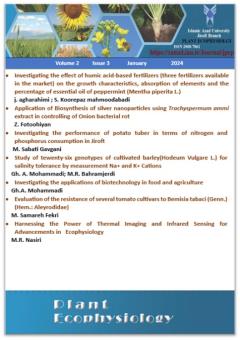-
-
List of Articles
-
Open Access Article
1 - Investigating the effect of humic acid-based fertilizers (three fertilizers available in the market) on the growth characteristics, absorption of elements and the percentage of essential oil of peppermint (Mentha piperita L.)
جابر آقارحیمی سهیلا کوره پز محمودآبادی -
Open Access Article
2 - Application of Biosynthesis of silver nanoparticles using Trachyspermum ammi extract in controlling of Onion bacterial rot
زینب فتوحیان -
Open Access Article
3 - Investigating the performance of potato tuber in terms of nitrogen and phosphorus consumption in Jiroft
مهدی ثباتی گاوگانی -
Open Access Article
4 - Study of tewenty-six genotypes of cultivated barley(Hodeum Vulgare L.) for salinity tolerance by measurement Na+ and K+ Cations
غلامعباس محمدی محمدرضا بهرامجردی -
Open Access Article
5 - Investigating the applications of biotechnology in food and agriculture
غلامعباس محمدی -
Open Access Article
6 - Evaluation of the resistance of several tomato cultivars to Bemisia tabaci (Genn.) (Hem.: Aleyrodidae)
معصومه ثمره فکری -
Open Access Article
7 - Harnessing the Power of Thermal Imaging and Infrared Sensing for Advancements in Ecophysiology
Mohammad Reza Nasiri
-
The rights to this website are owned by the Raimag Press Management System.
Copyright © 2021-2025







